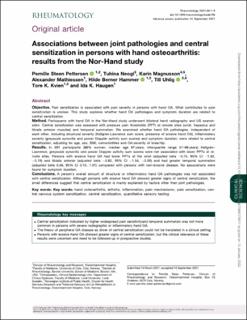| dc.description.abstract | Objective: Pain sensitization is associated with pain severity in persons with hand osteoarthritis (OA). What contributes to pain sensitization is unclear. This study explores whether hand OA pathologies and symptom duration are related to central sensitization. Method: Participants with hand OA in the Nor-Hand study underwent bilateral hand radiography and ultrasound examination. Central sensitization was assessed with pressure pain thresholds (PPT) at remote sites (wrist, trapezius and tibialis anterior muscles) and temporal summation (TS). We examined whether hand OA pathologies, independent of each other, including structural severity (Kellgren-Lawrence sum score, presence of erosive hand OA), inflammatory severity (greyscale synovitis and power Doppler activity sum scores) and symptom duration, were related to central sensitization, adjusting for age, sex, body mass index, comorbidities and OA-severity of knee/hip. Results: In 291 participants (88% women, median age 61, IQR 57-66 years) Kellgren-Lawrence, greyscale synovitis and power Doppler activity sum scores were not associated with lower PPTs at remote sites. Persons with erosive hand OA had lower PPTs at the wrist (adjusted beta -0.75, 95%CI -1.32, -0.19) and tibialis anterior (adjusted beta -0.82, 95%CI -1.54, -0.09) and had greater TS (adjusted beta 0.56, 95%CI 0.12, 1.01) compared with persons with non-erosive disease. No associations were found for symptom duration. Conclusions: A person's overall amount of structural or inflammatory hand OA pathologies does not appear to drive central sensitization. Although persons with erosive hand OA showed greater signs of central sensitization, the small differences suggest that central sensitization is mainly explained by other factors than joint pathologies. | |
